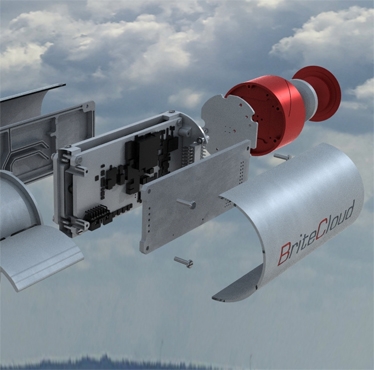
A UK manufactured system to create miniature decoys that will help to protect combat jets from missiles, has been snapped up by the MOD.
The MOD has placed a £2.5M order for the cutting-edge BriteCloud system, designed and manufactured in Bedfordshire and Scotland by Leonardo-Finmeccanica. The system can be fired from an aircraft’s flare dispenser without the need for modification to the aircraft and is packed with missile-confusing advanced electronics.
BriteCloud, which is similar in size and appearance to a beverage can, and can be fired from an aircraft’s flare dispenser without the need for modification to the aircraft. Once deployed, it uses powerful radar emissions to disrupt systems within radar-guided air-to-air and surface-to-air missiles.
A pilot can launch the compact unit, which is packed with advanced electronics, to confuse an attacking missile, drawing it away to a point where it no longer poses a threat.
Purchase of the system will enable the RAF to further evaluate BriteCloud’s protective effect with its fleet of Tornado jets and develop what the military calls a ‘concept of operations’ (or ‘CONOPS’) for the technology. A CONOPS essentially provides an instruction manual for the crews who will deploy with BriteCloud and the development of CONOPS is usually seen as the last step before the new technology goes into use on real missions.
Defence Secretary Michael Fallon said:”The cutting-edge technology behind BriteCloud demonstrates the MOD’s commitment to harnessing and growing the incredible creativity in our Defence supply chain.
“Supported by our £178 billion investment in equipment, these new decoy systems show that we are continually pushing the boundaries of innovation, making the most of Great British skills and brains to keep our Armed Forces safe from our adversaries.”
BriteCloud will be delivered by the electronic warfare experts at Leonardo’s Luton site. The decoy provides digital countermeasure protection against air-to-air and surface-to-air radar-guided missiles in a package the size of a 55mm flare. It is currently the world’s only such system to have been sold and proven effective via end-to-end testing. Based on miniaturised jamming technology, BriteCloud is able to launch from a standard 55mm flare dispenser with no extra integration required.
Successful initial trials were conducted in October 2015, which proved the effectiveness of the BriteCloud decoys against modern, representative Radio Frequency (RF) threats. The next step towards a potential adoption for operational use by the RAF is the development of a concept of operations. This will allow the RAF to characterise the behaviour of the decoy in realistic scenarios and develop ways to use it in combat. As part of this development, a series of further trials on RAF Tornadoes will take place later this year.
Chief Executive Officer at the MOD’s Defence Equipment and Support organisation, Tony Douglas said:“The development of BriteCloud has only recently been made possible after many years of advances in technology, and shows how UK Defence, in partnership with industry, is leading the charge when it comes to research and development.
Flight trials planned for later this year will test the system’s effectiveness against a wide range of current and potential threats, helping to ensure that UK pilots have the tools they need to successfully complete their missions wherever they are in the world.”
To date, the MOD has invested around £25 million in the BriteCloud system through a project commissioned by Defence Science and Technology Laboratory (Dstl) and managed by Defence Equipment and Support (DE&S). This new order will allow the RAF to explore how BriteCloud could best be deployed operationally, if successful, the system could be available for Tornado aircraft operations by mid-2017.
If you would like to join our community and read more articles like this then please click here
BriteCloud CONOPS Defence Secretary Dstl Innovation Leonardo-Finmeccanica Michael Fallon MP missile decoy MOD RAF RAF Tornado UK








